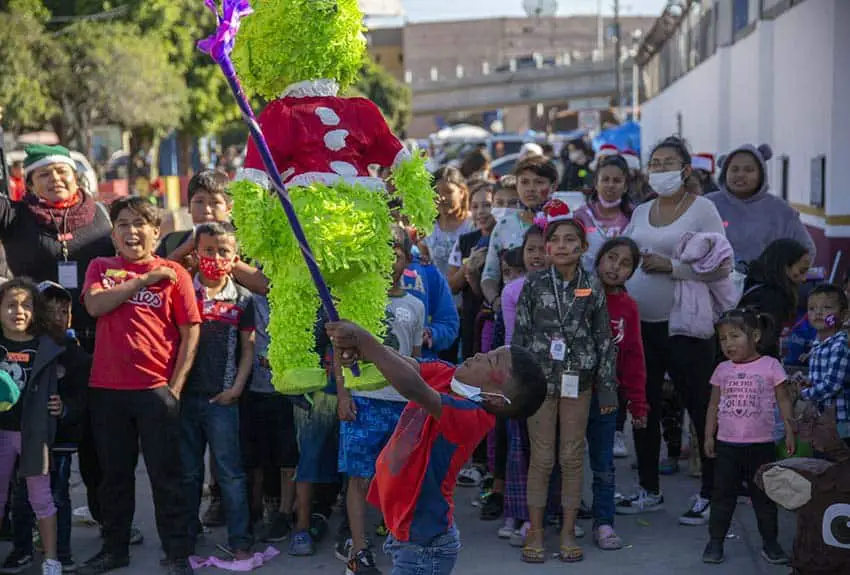The holiday season is here! Shops are filled with people buying sweets, fruit, tamales and a variety of snacks. People scurry home, carrying traditional seven-pointed star piñatas. The air is scented with the smell of traditional foods being prepared. The sound of villancicos — Christmas carols in Spanish — fills the air. Candles are getting hard to find. Alcohol is even harder to find.
Las Posadas has begun.
This time of year, which takes place from December 16 to December 24, is a religious festival celebrated in Mexico and other Latin American countries to commemorate the journey of Mary and Joseph from Nazareth to Bethlehem and the birth of Jesus (posada means “inn” or “lodging”). Some say the nine days symbolizes Mary’s nine months of pregnancy or the nine days of the journey, although the Bible does not mention how long it took Joseph and Mary to reach Bethlehem.
The real roots of that number are in a Catholic pope in the 1500s giving permission for nine masses to be celebrated in Mexico before Christmas.
When people today talk about Las Posadas, they are usually referring to nine days of parties with warm punch, baskets of sweets, lights and piñatas, traditions brought over by Spanish Catholic priests trying to convert Mexico’s indigenous population.

But one could also say that the tradition of Las Posadas really began with the pre-Hispanic Mexica (Aztec) celebration called Panquetzaliztli, which lasted 20 days and involved placing flags — colorful pennants made of amate bark — in the trees and at the temple. Figurines of the deity Huitzilopochtli were carried in a procession that had different stations, where rituals and offerings took place.
The final part of the celebration took place with song and dance and offerings of regional foods, corn tortillas and pulque (a fermented alcoholic beverage made from the maguey plant still drunk in Mexico today). In one ritual, a stick was used to break open a clay pot filled with items.
When the Spanish arrived with Catholicism, the clergy found that the similarities between the Aztec ceremonies and the traditions of the Catholic church during the month of December provided them with an opportunity to evangelize through pageantry about the story of Jesus’ birth.
In 1587, Diego de San Soria, the prior of the San Agustín Acolman monastery near Mexico City, received permission from Pope Sixtus V to conduct misas de aguinaldo (bonus masses) every day for nine days leading up to Christmas Day. These masses were held outdoors, and a celebration would follow. Small gifts were given to attendees.

Gradually, as Catholic evangelism succeeded in Mexico, Las Posadas and Christmas replaced Mexica traditions. Las Posadas came to include processions that reenacted Mary and Joseph’s search for a room at an inn for Mary to give birth, processions still held today.
The participants would follow a route that passed predesignated homes and knock on each door. The homeowner answered the door as the innkeeper, with both sides singing a litany back and forth: the group outside sang to pedir posada, or plead for a room for the night, so that Mary could give birth. Those inside said no rooms were available. This is still how this ritual of pedir posada is conducted today.
When the group outside reaches the door of the final house, it’s invited inside. In some cases, participants then kneel in front of a nativity scene and pray, whereas in other cases, a party simply begins. But either way, the final home represents the stable Mary and Joseph were given to sleep on the night Jesus was born.
Originally these processions were sponsored by religious groups. Many small towns and villages still conduct this traditional procession during Las Posadas, but they are typically held in neighborhood communities.
By the 19th century, Las Posadas were firmly entrenched in Mexican culture, incorporating elaborate nativity scenes, decorations and fireworks.

There are many ways to celebrate this religious festival, and each region of Mexico has made changes that reflect local traditions. Las Posadas is also celebrated in Honduras, Guatemala, El Salvador, Costa Rica, Nicaragua, Panama and even in some cities in the United States.
Although the way Las Posadas is celebrated varies from community to community in Mexico, certain elements are always present — food and drink, music, sweets and the piñata.
While many think of the piñata as merely a party activity, it’s a critical religious component of Las Posadas.
The Spanish brought the piñata to the Americas and brought along the symbolism they had attached to it: the piñata’s seven-pointed-star construction represented the seven capital sins (a.k.a. the seven deadly sins). Over time, the symbolism expanded, with the bright colors and tinsel decorations attached to the piñata said to symbolize the temptation of the capital sins.
Blindfolding the child who will try to break the pinata with a stick represents blind faith in the power of God, and the piñata breaking symbolizes defeating temptation and receiving the gifts of God’s grace — the sweets and items that are released from the broken piñata.

Despite having traditions going back centuries, posadas also continue to evolve: since the middle of the 20th century, the lantern decorations originally used during a posada have been replaced with strings of colored light bulbs, and sparklers are often handed out to guests. Other more modern additions include small party bags of treats called aguinaldos as well as fireworks, and the ponche navideño — a Christmas punch made with sugarcane, fruits and cinnamon sticks — spiked with alcohol for the adults.
At the posada celebration, different foods and refreshments are served, depending on the region: pozole, mole dishes, buñuelos, atole and, of course, the ever-present tamales.
Sheryl Losser is a former public relations executive and professional researcher. She spent 45 years in national politics in the United States. She moved to Mazatlán last year and works part-time doing freelance research and writing.
